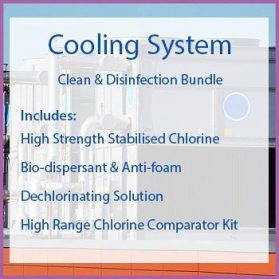Description
Acid Cleaning Bundles
Descaler SF Bundle
- Descaler SF 25kg (liquid)
- Neutralising Powder 25kg keg (powder)
- Low range pH strips
Descaling Powder Bundle
- Descaling Powder 25kg keg
- Neutralising Powder 25kg keg (powder)
- Low range pH strips
Chemical & Metal Suitability Table
| Iron / Steel | Copper & Brass | Stainless Steel | Galvanised Steel | Aluminium | |
|---|---|---|---|---|---|
| Descaler SF | Yes | Yes | No | No | No |
| Descaling Powder | Yes | Yes | Yes | No | No |
Descaler SF Bundle
- Based on Hydrochloric Acid
- Incorporates film forming inhibitor
- Protects carbon steel, copper & brass
- Highly effective penetrant
- Dissolves limescale & rust
Product Description
DESCALER ‘SF’ is a highly active cleaning agent based on Hydrochloric Acid and a special film forming inhibitor to protect carbon steel, copper and brass against acid attack.
The inhibitor also serves as a penetrant and dispersant to enhance the effectiveness of the acid. DESCALER ‘SF’ also contains an exhaustion indicator. DESCALER ‘SF’ can be used to dissolve limescale (calcium carbonate) and rust deposits in boilers, calorifiers and heat exchangers. DESCALER ‘SF’ should NOT be used on stainless steel, aluminium or galvanised surfaces.
Product Usage
DESCALER ‘SF’ can be used at strengths between 10 and 50% and at temperatures up to 80oC, the speed of reaction being enhanced by acid strength and elevated temperature.
When the acid is approaching exhaustion the colour of the solution will change from red to yellow and this indicates that more DESCALER ‘SF’ should be added.
After completion of descaling equipment should be drained and flushed thoroughly and any acid effluent neutralised with Neutralising Powder.
acid cleaning Heat Exchangers or calorifiers
Initially add 10 litres of DESCALER SF for every 100 litres of water in the circuit. This will usually cause foaming as the acid reacts with the calcium carbonate.
Once the foam has died down it is an indication that either the cleaning solution has lost its strength or the scale has nearly all reacted. To test this take a sample of cleaning solution and carry out an acid concentration test. If the acid concentration test indicates a low concentration then a further 5 litres of DESCALER SF for every 100 litres of water in the circuit.
Once no more foam is generated by the addition of acid the system should be left to circulate for 1 hour prior to flushing and neutralisation.
The effluent should be neutralised to between pH 6 and 9 by the addition of Neutralising Powder prior to disposing to sewer.
(Extracts taken from heat exchanger acid clean procedure)
acid cleaning steam boilers
Contact Feedwater for specific guidance or for a quotation to carryout this type of cleaning for you.
DESCALING POWDER BUNDLE
- Incorporates protective film inhibitor
- Protects mild & stainless steel, copper & brass
- Effective penetrant & dispersant
- Dissolves limescale
PRODUCT DESCRIPTION
DESCALING POWDER is a highly active cleaning agent based on Sulphamic Acid supplied with a special film forming inhibitor to protect mild steel, stainless steel, copper and brass against acid attack. The inhibitor also serves as a penetrant and dispersant to enhance the effectiveness of the acid.
DESCALING POWDER can be used to dissolve limescale (calcium carbonate) deposits in boilers, calorifiers and heat exchangers.
DESCALING POWDER should NOT be used on aluminium or galvanised surfaces.
HOW TO USE
Depends on degree of scaling. Normally a 10% solution (100g per litre) will remove carbonate deposits. Up to 30% solutions may be used at temperatures below 70oC for removal of stubborn deposits. The inhibitor solution should be added at rate of 250ml per 25Kg of powder.
Completion of descaling should be determined by either testing acidity or pH periodically. When descaling is complete acidity or pH should be constant. If solution shows no acidity or pH rises to 4 or higher then more Descaling Powder solution should be added.
After completion of descaling equipment should be drained and flushed thoroughly and any acid effluent neutralised with Neutralising Powder.
ACID CLEANING HEAT EXCHANGERS OR CALORIFIERS
Initially add 5kg of DESCALING POWDER for every 100 litres of water in the circuit. This will usually cause foaming as the acid reacts with the calcium carbonate.
Once the foam has died down it is an indication that either the cleaning solution has lost its strength or the scale has nearly all reacted. To test this take a sample of cleaning solution and carry out an acid concentration test. If the acid concentration test indicates a low concentration then a further 2.5kg of DESCALING POWDER for every 100 litres of water in the circuit.
Once no more foam is generated by the addition of acid the system should be left to circulate for 1 hour prior to flushing and neutralisation.
The effluent should be neutralised to between pH 6 and 9 by the addition of Neutralising Powder prior to disposing to sewer.
(Extracts taken from heat exchanger acid clean procedure)
ACID CLEANING STEAM BOILERS
Contact Feedwater for specific guidance or for a quotation to carryout this type of cleaning for you.







